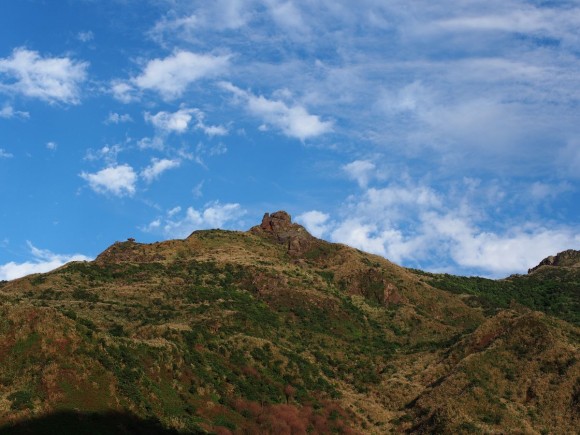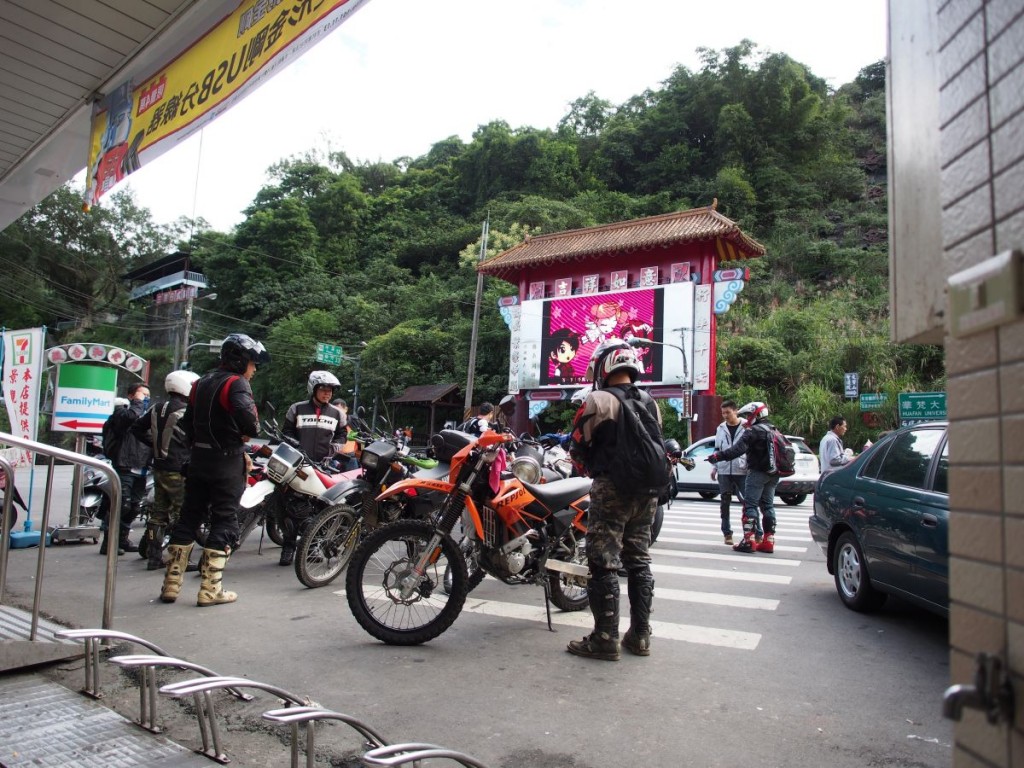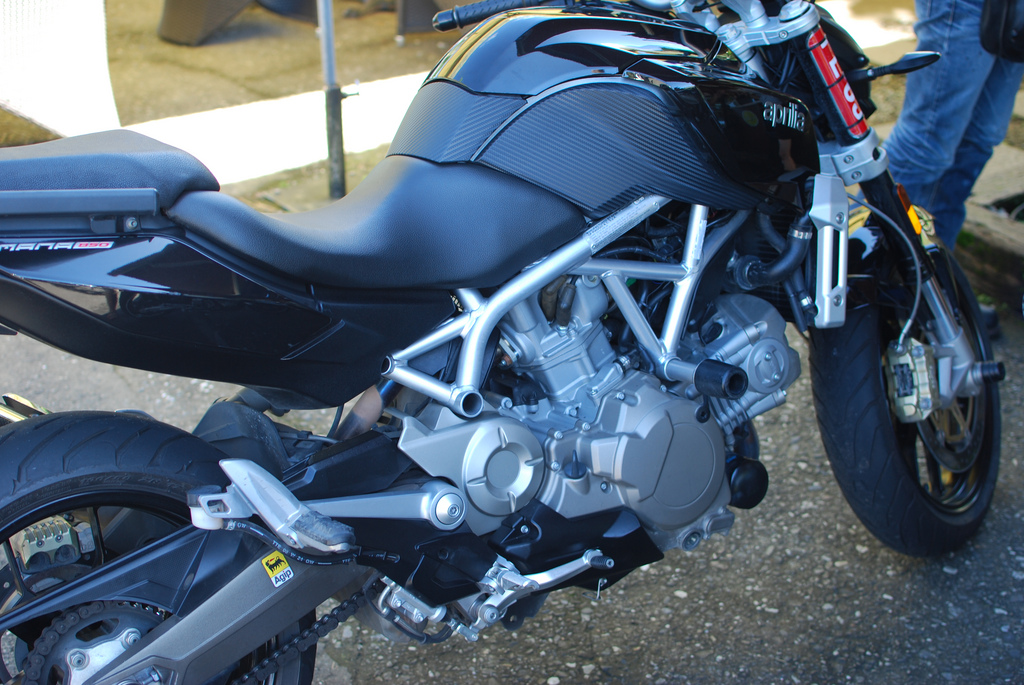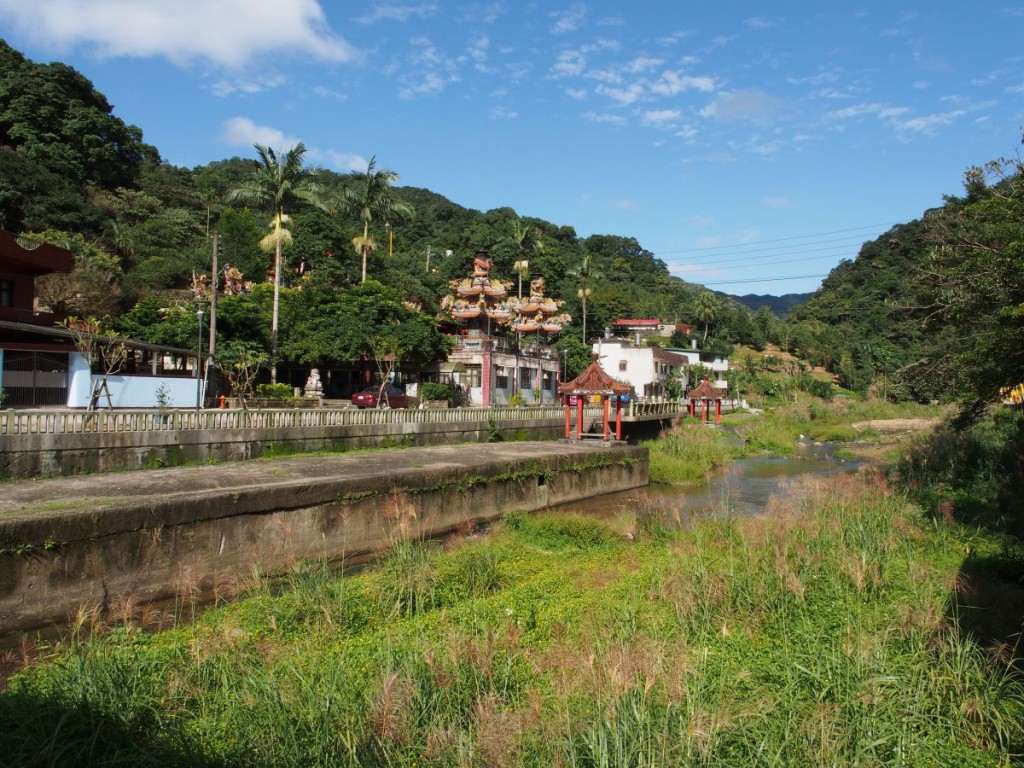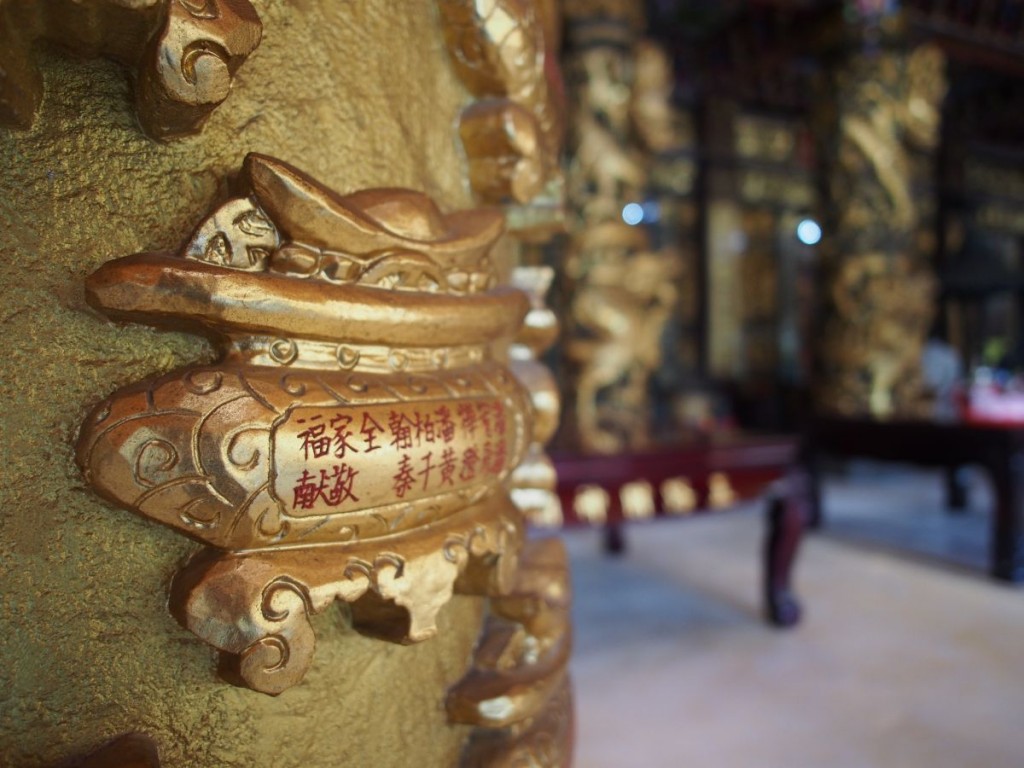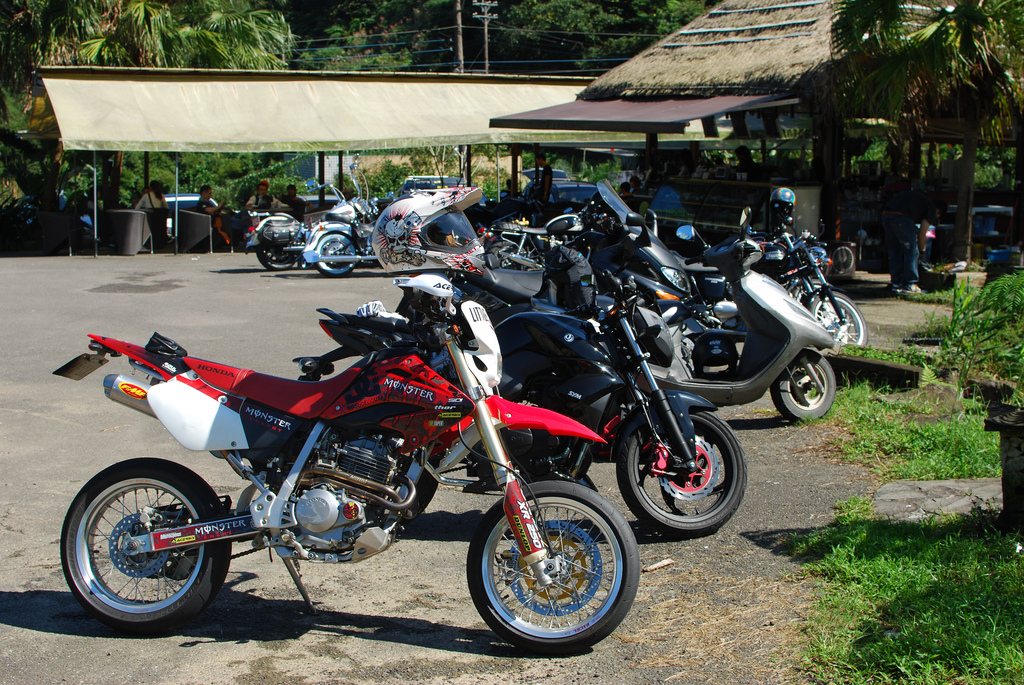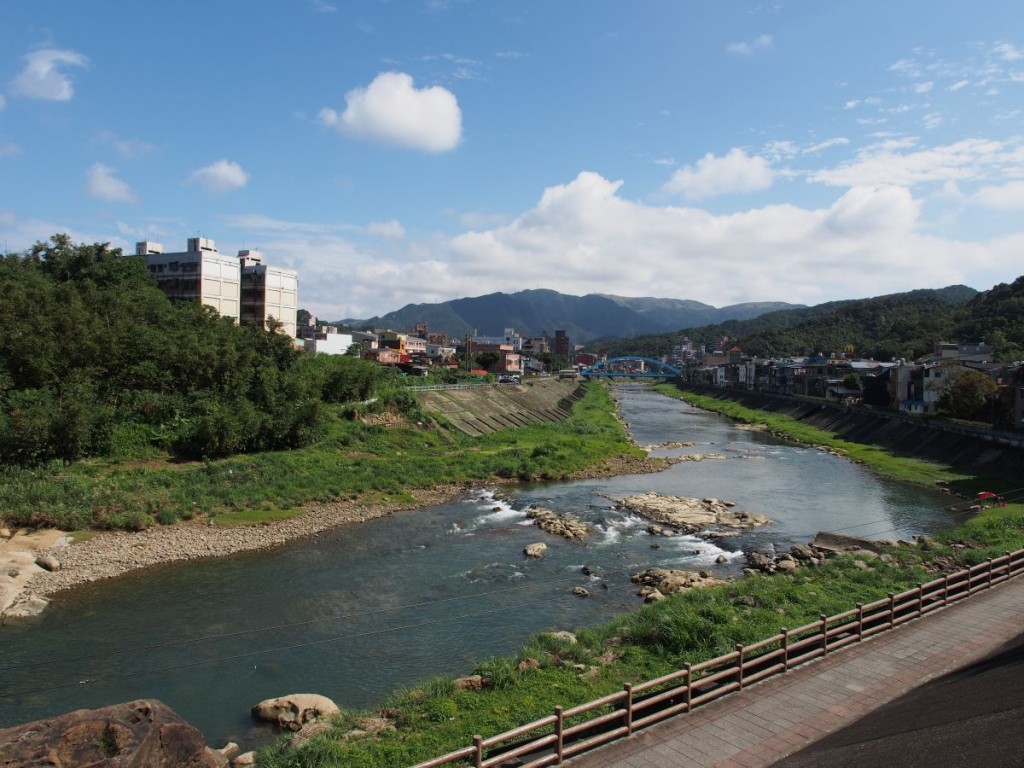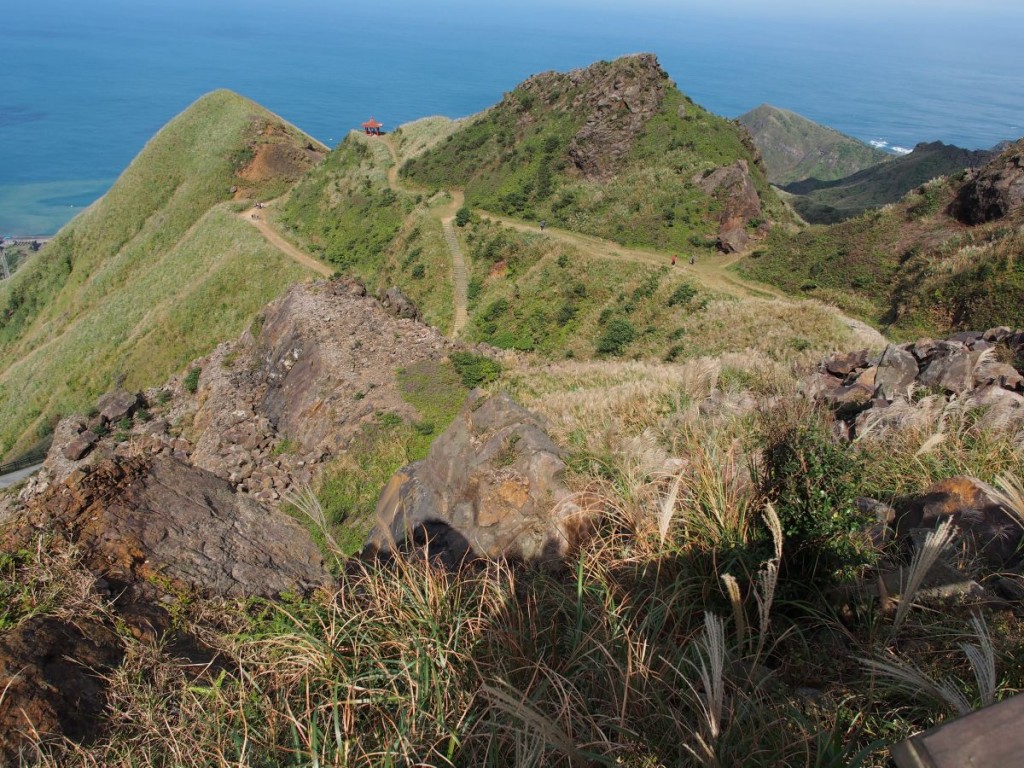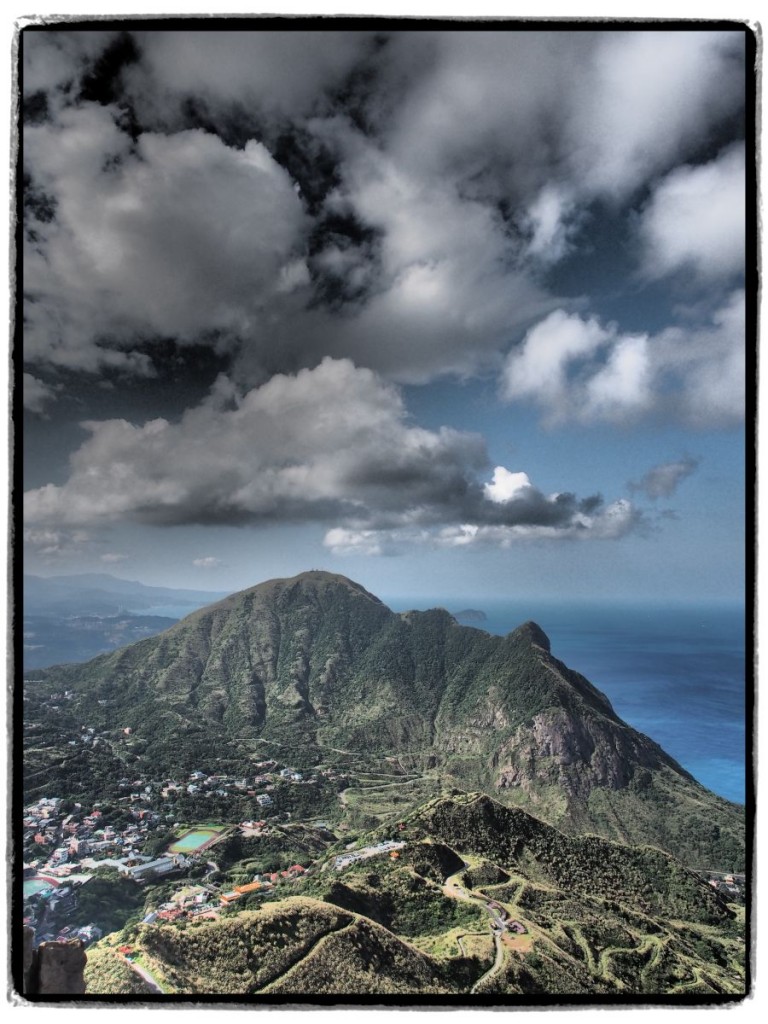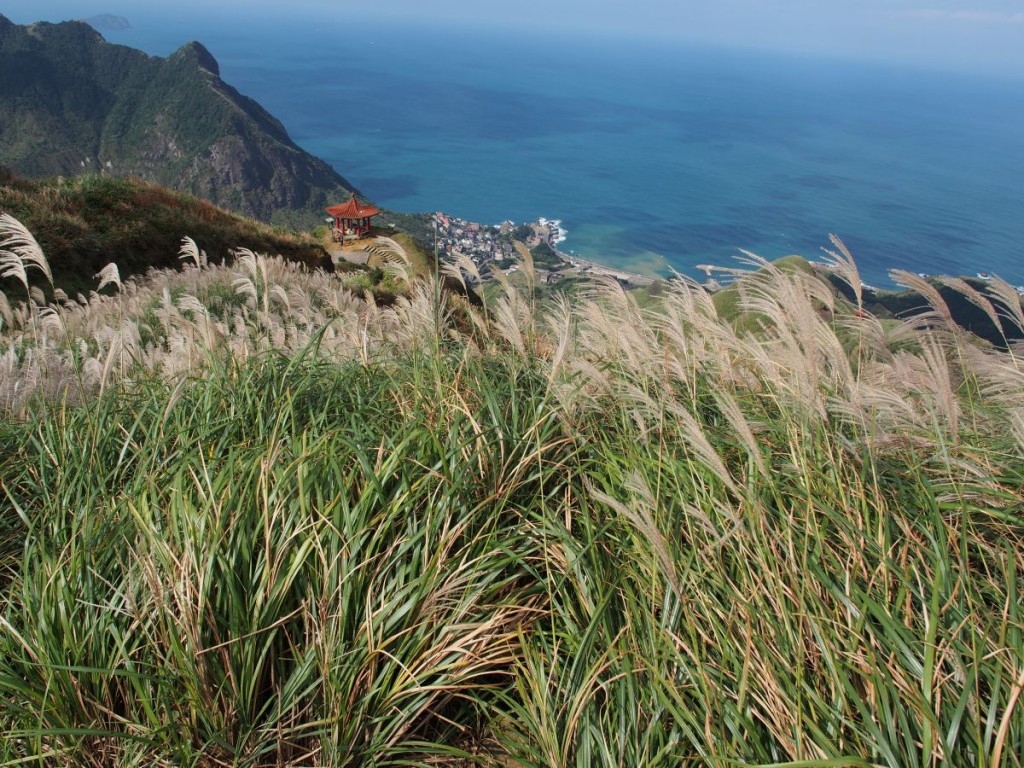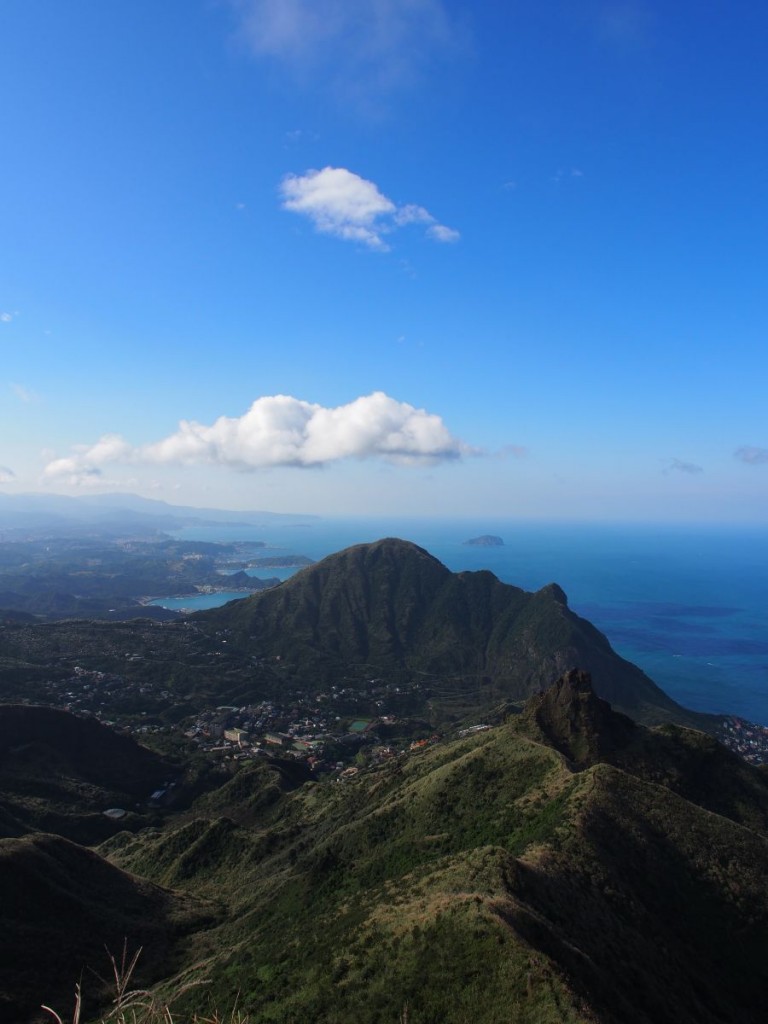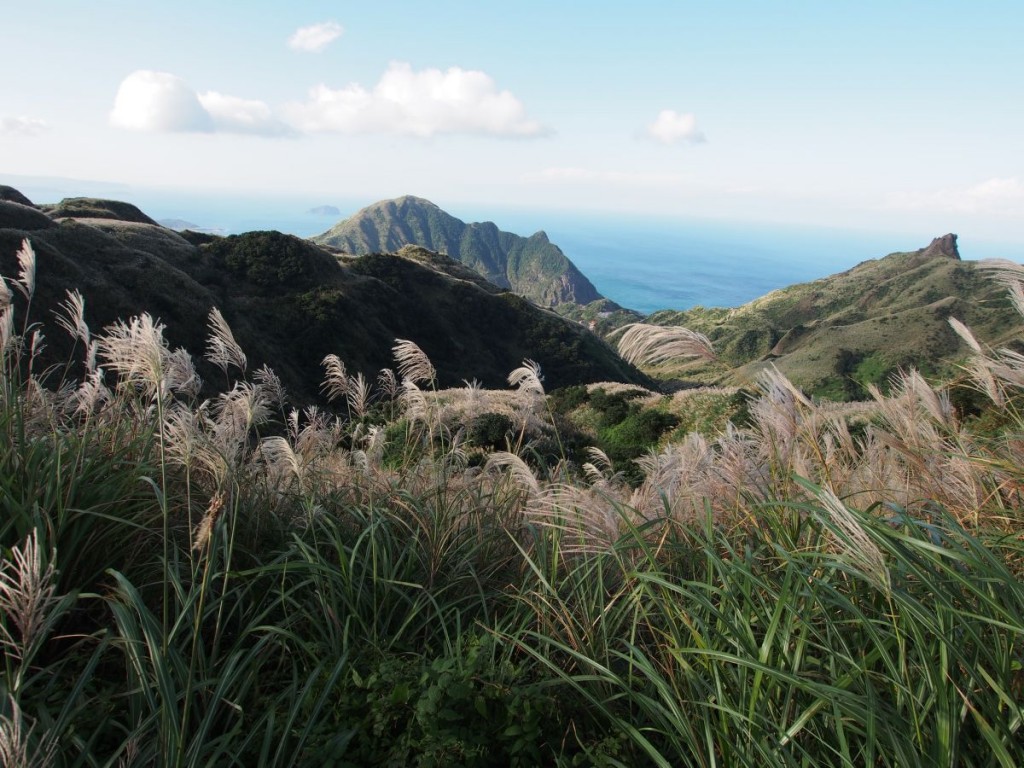Hiking Teapot Mountain and Banping Mountain near Jinguashi
November 4, 2012
I woke up on Saturday not entirely sure what I was going to do. I had had vague ideas the night before of driving somewhere into the mountains around Taipei and going for a hike, but I could just as easily have hung out in the city. In the end, it was the weather that decided me. It was sunny and clear, and being early November, it could be the last sunny and clear weekend day we get in Taipei for months. So I made up my mind to go for a hike.
I packed an overnight sack (in the movies, they pack overnight bags, but I generally use stuff sacks) in case I decided to stay overnight anywhere. The weather reports were poor for Sunday, so I didn’t think that was likely, but I wanted the option. It was already nearly 9 in the morning, much later than I’d like for a weekend trip departure, but the roads were still quite empty and I zoomed out of Taipei following my regular route to the Taipei Zoo. At the Zoo, I picked up Route 106, which heads to the mountain mining towns of Jingtung, Pingxi, and Shihfen.
It’s a bit of a long urban journey to get out of Taipei, but I had some new podcasts going and the time passed easily. Where Route 106 splits – the main branch going to Pingxi and the small branch going to Shiding – I stopped for a morning coffee. There are a 7-11 and an OK-Mart right there, and it is a popular and convenient spot, as evidenced by the dozens of bikers and motorcyclists you find there pretty much all weekend long. On this particular morning, the majority of the weekend warriors were on big dirt bikes. They were set up for off-road riding, but I’m not aware of any off-road riding in this part of Taiwan. They were probably just driving them on ordinary roads.
It was pretty loud as I saw there with my coffee. They were revving the dirt bike engines and lots of other motorcycles and scooters and cars were coming and going. At one point, a convoy of about ten sports cars raced past, taking the corner at high speed. They were all the same car but in different colors. I’m not a car expert, so I’m not sure what kind of car they were, but they looked closer to a heavy street car like a Transam than a smaller sports car. In any event, they were pretty flashy and all decked out with spoilers and other add-ons. The engines were clearly souped up, too, as the noise was deafening as they passed. All of them were going far over the speed limit, but that is the norm for the Pingxi route on the weekend. It’s treated as a race course by the motorcycle and car clubs. Mixed in with the motorists and motorcyclists was a smattering of cyclists with lightweight speedster bikes, head-to-toe colorful Lycra, and clip-on biking shoes. I think a lot of these pursuits spring from a sense of boredom. We pick up these hobbies out of a sense of boredom and in an attempt to fill the gaps in our lives. Cycling is a good one for that since there is so much shopping that can be done. These cyclists had clearly taken advantage of that opportunity and decked themselves and their bicycles out with every accessory imaginable. The motorcyclists were the same but I imagine in a much higher price bracket. Their full racing suits were probably quite expensive as were their bikes and the things they needed to maintain them.
I often find I am the odd man out in these gatherings with my standard scooter. There are lots of other scooter drivers there, but they tend to drive high-end racing scooters and they deck themselves out with specialized clothing to equal the motorcycle drivers. My scooter is a standard one – just one of the tens of thousands of beat up models you see on the streets of Taipei. I only realize how dumpy it looks when I see it mixed in with the high-end crowd of Ducatis and BMWs. While driving the scooter, I have the mindset of these racers, I suppose. I feel like I am racing along the roads, taking the corners, wind in my face, cool and free. To these guys, I imagine I look quite strange – a large-framed dude sitting on this little putt-putt machine. I’ve only seen one picture of myself actually driving the scooter. That was taken by a traffic camera, which caught me driving in the bus lane and which was sent to me along with the ticket. In that picture, I don’t look cool at all. I look the opposite of cool. The scooter looks too small for me and I’m hunched over it with my giant bulbous black helmet and I don’t look cool at all. I look pretty awkward.
Later in the day, in fact, one of these guys on a very elaborate and beautiful motorcycle even made fun of me. It was weird because that had never happened before. My scooter was parked beside his motorcycle at a roadside coffee shop, and when I was getting back on my scooter to leave, he started talking to me. I didn’t follow his exact words, but he was pointing at my scooter and to his motorcycle and saying “better, better” and smiling. He was obviously very proud of his motorcycle and he was recommending that I trade in my scooter and trade up. I have thought of buying a motorcycle in the past. Of course, I wouldn’t buy one of these expensive racing bikes. I’d have gotten a standard farmer’s bike or something. The idea was that it would likely be more comfortable for long trips through the countryside. The problem there is that I rarely manage to put together enough time off work to go on long road trips. So there is no great need for such a motorcycle. The scooter does me fine, and, like most people with their vehicles, whatever they are, I’m quite fond of it.
While sitting at the convenience store and enjoying my coffee, I was entertained by a couple of stray cats. They were beautiful cats and sat in the sun grooming themselves with occasional glances toward the door. The reason for the glances soon became clear as the clerk at the convenience store emerged with a plate of cat food for them. He put the plate on the ground near my table. He put the plate right on a steel grating that was covering up a water drainage trough. This is significant because all the cyclists with their clip-on shoes stepped on this steel grating. These clip-on shoes are almost impossible to walk in and these guys were taking awkward wobbly steps and when these hard clips came down on the steel grate, it was with a loud and violent clang which startled the cats into fleeing. Once the danger was assessed, the cats would return to the plate and keep eating – until the next cyclist stepped on he grating. “Clang!” and the cats would sprint away.
At one point along Route 106, the road takes a very sharp turn to the right and climbs up steeply affording you with a nice view of a large temple complex. I’d noticed that temple complex many times in the past and even taken pictures of it, but I’d never stopped to take a look. This time, with a new camera lens to test, I decided to pull over and take a walk to the temple and check it out.
It’s a fairly important temple, I know. I’ve seen a lot of big events taking place there with parked cars overflowing all the available parking areas and nearly blocking the road. I learned on this trip that the temple is dedicated to wealth and fortune. That is evidenced by the hundreds of symbols of money everywhere. I don’t know what these things are called, but I believe they are silver and gold ingots that various Chinese dynasties used for money. They are shaped oddly – like toy boats – and come in many different sizes. I’ve seen them in museums here quite often. This particular temple was covered with these ingots. They were lined up along the walls and imprinted on the pillars and surrounded all the water fountains, incense burners, and ghost money furnaces. (The ghost money furnace was, by the way, the largest I’ve seen in Taiwan so far.) I know that most temples here are decorated with gold paint but this temple, being dedicated to wealth, seemed to have more gold paint than any temple I’ve ever seen.
I took some pictures with my new lens and fell into conversation with Charlene. She was a woman in perhaps her late fifties. She had been born in Taiwan but had been living in the United States for the last twenty years. She was in Taiwan visiting family, and one of her family members suggested they go on a short road trip on this sunny day to see the towns of Pingxi and Shihfen and the Shihfen Waterfalls. Chatting with her was interesting because I could see how her conversational patterns had been shaped by living in the United States. Chatting with her felt very natural and normal and she came out with all these questions and statements that are perfectly familiar from a western point of view and yet which I never hear in Taiwan – where conversation has a different pattern. In fact, that we were even chatting at all was unusual. It’s not something that generally happens in Taiwan – falling into conversation with a stranger. That is mainly because I don’t speak Chinese, of course, but it’s also because of a cultural habit, I believe. It’s just not something that happens here as a rule. At least it doesn’t happen to me. There are exceptions, and I have met some people and gotten to know them through casual encounters on the road, but those exceptions prove the rule. These people that I meet in this way are always quite unusual in some way – different from the norm. Anyway, I don’t want to make a big deal of this. I mention it because in the middle of my conversation with Charlene, I had this moment where I realized how odd it was. I was having this perfectly normal conversation and it was following a pattern that I was totally comfortable with. It was like putting on an old comfortable pair of shoes. Then it occurred to me that as comfortable and familiar as the conversation was, I hadn’t had that experience for a long time and it suddenly felt quite odd to be having that conversation while standing there looking at a Chinese temple covered in gold paint.
My next stop on this journey was a roadside coffee shop just past Pingxi. I’ve stopped at this spot many times on other trips, and I always enjoy it. It’s a hangout for the motorcycle clubs – a place where they can gather and compare bikes and have a cup of coffee. It was here that the guy pooh-poohed my scooter and suggested I move up in the world. I have a bit of a love-hate relationship with all these fancy coffee shops in Taiwan. Most of the time, I avoid them. They charge upwards of NT$120 for coffee and then they end up serving coffee that is lukewarm at best. I know most people don’t care. Lots of people actually don’t drink their coffee until it cools down to room temperature. I want my coffee piping hot, and it is such a huge disappointment when my first sip proves it to be lukewarm. When it is lukewarm, I can down it in one or two swallows – like a glass of water – and then it is gone. What is the point of that? Where is the long pleasure of sipping a hot cup of coffee when it is like tepid tap water? This is why I almost always end up in a 7-11 to get my coffee. It is a third of the price, tastes better, and is always piping hot. Lately, I’ve really enjoyed a video that I’ve seen on the monitors in 7-11s around Taipei. The video shows one of 7-11’s coffee machine maintenance guys on his rounds. He visits various 7-11s and puts their coffee machines through their paces, cleaning them, testing them, and otherwise maintaining them. He’s got a suitcase of specialized tools for this and I’m left with the impression of a highly skilled technician at work – like a wine expert inspecting the vats. At one point in the video, you see the technician with a high-tec thermometer making sure that the machine is producing water or milk at the exact right temperature. You never know what you are going to get at a fancy coffee shop. Well, that’s not completely true. You know you’re going to get a big bill and rather poor service. I’m not sure why these places feel they can charge as much as they do. The décor? At least at 7-11 you know exactly what you are going to get – and you get it almost all the time. Even other convenience store chains can’t compete. I’ll always choose the 7-11 over a Hi-Life or OK-Mart if they are near each other. Sometimes you get a hot coffee at a Hi-Life, but it’s a crap shoot. At OK-Mart, it’s rarely hot. I avoid them when I can. I guess I’m a 7-11 kind of guy. I even prefer the food there to the food I get almost anywhere else. A simple place for a simple guy.
From the motorcycle club coffee shop, I had a choice to make. I could either double back to Pingxi and do a hike there or I could continue on to Jioufen and Jinguashi and do a hike there. It all depended on the weather. At one point, heavy dark clouds were gathering over the mountains to the east, and I decided to go to Pingxi and keep the day short and simple. However, when I got on my scooter and got to the road to make my left-hand turn, the skies had cleared and there were beautiful blue skies all the way to the eastern coast. So I changed my turn indicator from left to right and set course for Jinguashi and Teapot Mountain.
I got the idea to climb Teapot Mountain from Stu Dawson’s hiking blog “Hiking Taiwan”. His most recent post was about the climb to Teapot Mountain and then on to Banping Mountain. What caught my eye, of course, were the pictures. I’m all about beautiful views. Why else climb to the top of a mountain if not to look at the view? With these clear blue skies, it seemed the perfect time to climb Teapot Mountain.
The drive to Jinguashi and Jioufen is very familiar to me by now. I’ve done it so many times that I feel like I could do it with my eyes closed. It makes me smile to think back to the first time I did it (it was on a bicycle) and how it seemed such a great adventure. I had no idea where I was going and had to refer to maps at every intersection. Now I just zoom straight there and tick off the various sights along the way as old friends. I’d even done a bit of hiking in the Jinguashi area before and quite enjoyed it. It’s an extremely beautiful area and offers views of the mountains and the ocean – a wonderful combination. I had never, however, actually climbed up to Teapot Mountain.
The blog post said that the jumping off point for the trail to Teapot Mountain was the Gold Ecological Park. A great thing about this place is that they have a big parking lot dedicated to scooters. It’s nearly impossible to find, and if you don’t know it’s there you’ll probably wander around for half an hour to an hour looking for a place to park your scooter, but once you know it is there, it is wonderful. You follow the main winding road down into Jinguashi following the signs to the Gold Ecological Park. Just before you reach the park entrance itself, there is a steep driveway on the right. It looks like it is blocked, but apparently it is only blocked to cars. With a scooter you can scoot through the openings, climb up to the top, and you are greeted with a couple of hundred inviting scooter parking spots. It’s a rare thing in Taiwan, and I love it.
I had a bit of trouble finding the starting point for the trail. That’s normal for this sort of thing. It’s perfectly easy and obvious once you know where it is, but the first time, it’s tricky. Luckily, Teapot Mountain and the surrounding ridges tower above Jinguashi and are visible from everywhere. I simply kept Teapot Mountain in my sight and started moving towards it, hoping that the trail would suddenly make an appearance. As it was, I made things much more difficult than they needed to be. The trail begins at the very back of the Gold Ecological Park. You simply walk through the park and work your way to the back where the main exhibit building is located. From there, a wide path goes off to the left across a bridge leading towards a famous temple. The Teapot Mountain trail starts right on the other side of the bridge on the right. One trick is that the English sign does not say Teapot Mountain. It has the Chinese name for the mountain written in English letters. So even when I found this trail entrance, I wasn’t entirely sure it was going to Teapot Mountain. However it was a good guess, and even if it didn’t, the trail was clearly going up the mountains and would probably lead somewhere interesting. My original attempt hadn’t brought me directly there. I had somehow ended up on a path out of the park that led me down deep into the valley across a river and then back up the other side. There, my trail joined the wide path going to the temple. I followed that path back to the park and that’s when I found the trail entrance. My route meant I had gone far out of my way and already done a lot of climbing I hadn’t needed to do. But that was okay. Jinguashi is a great place to explore and I didn’t mind wandering around a bit – especially when it became clear that I had found the right trail in the end.
The start of the trail consisted entirely of steps and I plodded my way up stopping to take the occasional picture. To my surprise – and a bit of displeasure – the trail I was on ended at a road. I then had to follow the road for a kilometer or so to the left to a lookout point, where the main trail to Teapot Mountain continued. I say I felt a bit of displeasure because it is always weird to climb for a long time only to find yourself at a spot that you could have driven to easily. Still, it was no big deal. The point of a hike is to hike, so it is no bad thing to hike even when you could have driven to the same spot.
From that point, the trail no longer consisted of steps. It was a simple rock and dirt trail heading upward through silver grass providing beautiful views of Jinguashi and Keelung Mountain and the river valley. It was not a difficult climb at all and in just a few minutes, I was at the base of the peak of Teapot Mountain. The mountain was given this name because the large pile of rocks at the peak looks pretty much exactly like a teapot from certain angles. To climb up that pile of rocks requires a little bit of scrambling with the use of fixed ropes. It’s no big deal, though. I just had to put my camera away because I needed both hands for the rope. To continue to the top of Teapot Mountain and then on to Banping Mountain, you have to actually climb through the pile of rocks. This involves a bit of scrambling through a narrow passageway. Anyone with a large backpack would probably have to remove it in order to fit through.
The views from there were wonderful and I rested for a while and took some pictures. I spotted the trail leading from Teapot over to Banping Mountain and there were several large groups of hikers heading my way. One group of 18 reached Teapot Mountain while I was still there. They were a happy group dressed in the latest (very colorful) hiking gear. I chatted with a young guy who had a GoPro video camera in a waterproof housing strapped to his head. He said they had started in Jinguashi and come around the ridge through Banping Mountain to here. I wasn’t sure I was going to continue on to Banping Mountain. I thought it might take too long, but this guy said that a Canadian like me (he felt all Canadians were serious outdoorsy people) could reach the top of Banping Mountain in twenty minutes. It was actually much earlier in the afternoon than I expected and, assuming I didn’t mind driving back to Taipei in the dark, I had more than enough time to make even a longish hike back to Jinguashi, and I set off.
I felt I had to live up to the outdoorsy reputation of all Canadians and I kept up a fast pace – well, a fast pace for me. It was a great walk. The trail was not so much a trail as a tunnel through fields of silver grass that grew far above my head. The growth was so thick that I often couldn’t see my feet or the trail below me. I had to feel my way with my feet and then break through the grass with my hands stretched out in front of me. It was a bit risky because the trail was quite wet and muddy and the rocks I encountered were very slippery. It would have been easy to twist an ankle, and I tried to be careful even as I kept up a fast pace. I had a couple of amusing moments encountering other hikers coming in the other direction. The other hikers were as blind as I was in the tall grass and we only saw each at the very last second and, once, even touched outstretched hands as we stumbled into each other.
The trail followed a ridge along a flattish area and then started the climb up to Banping Mountain. Again, it wasn’t a difficult climb in any way, but it got quite slippery at times and I lost my footing occasionally and had to grab bunches of tall grass to steady myself. The final climb to the top is straight up a steep rocky cliff and you have to pull yourself up by a long rope while finding the notches cut out of the rock for your feet. At the top, I got my reward – incredible views of Jinguashi and the surrounding mountains and coast. The wind up there was very strong and I had to be careful as I moved around snapping pictures. Other hikers were up there and some of them weren’t happy about their situation. Two women were clutching a rock outcropping and kind of screaming and laughing as the wind threatened to blow them off the top. It didn’t look like they were going to find the courage to let go of that rock any time soon.
It was decision time again. I had to decide whether to continue around the mountain ridge and then down to Jinguashi or retrace my steps through Teapot Mountain. In hindsight, it is clear that the better choice was to retrace my steps. However, I didn’t know that and since I hadn’t seen what lay around the mountain ridge, I set off in that direction. The trail here was also more of a tunnel than anything else. It was also quite narrow and I was held up on a number of occasions as I had to wait for large groups of hikers coming in the other direction. I’d never seen so many hikers on a trail before, so I guess this trail is a popular one. Most of these groups were very surprised to see me and they always had the same question: “You are alone?” My being alone astonished all of them and they gave me a big thumbs-up and called to each other this amazing fact. Several people also noticed my Teva sandals and were equally astonished that I would attempt this trail in anything less than full-on hiking gear. One woman bent down and touched my bare foot in surprise while calling out to the others this discovery. I can only assume that these people had come from some much further destination that Jinguashi. I can’t imagine that just coming from Jinguashi they’d be in such “super hiking” mode. I even came across one young man who, apparently, had been utterly defeated by the trail. He lay flat on his back in the middle of the trail, his limbs splayed out and his faced covered with a towel. His hiking companions had warned me of his presence ahead on the trail so that I wouldn’t step on his face, and I had to gingerly step over him, as did all the other hikers.
I said that I would have been better off to return back through Teapot Mountain, but going this way did afford me some interesting and beautiful views of the scenery to the south. And now I knew what lay in that direction. If I hadn’t continued on, I always would have wondered. The trail ended in a relatively short time at a road and I guessed that I had to follow the road around to the right in order to find a trail leading back down to Jinguashi. I eventually found a likely looking trail and began the surprisingly long descent. This trail consisted of steps all the way down to the bottom and there seemed to be no end to them. Perhaps steps have a different psychological effect than a regular trail. In any event, I seemed to be going down forever – going down far further than I felt I had climbed up. I also got some beautiful views of Teapot Mountain and Banping Mountain from a different angle and with the late afternoon sun hitting them just right, they were a beautiful sight. I made my way through the Gold Ecological Park and pack to my scooter and started the long drive back to Taipei. I’d have preferred to stay the night, but everyone was saying that it was going to rain on Sunday, so there was no point in staying.
My scooter isn’t really designed for nighttime travel. The headlights – despite asking several mechanics to fix them – are angled upwards and don’t illuminate the pavement in front of me so much as the stars above me. There was enough light from other sources, though, to light up the road and I was fine. In fact, I had too much light to guide me. The road was jammed with traffic heading back to Taipei and I occasionally pulled over to the side to let large groups of cars (usually stuck behind a bus) go past me. Then I’d start driving again when the road was clear. Most other scooter and motorcycle riders took the opposite approach and tried desperately to pass the cars and buses in front of them. I rarely see the point of that. Sure, you can pass the twenty cars and two buses ahead of you, but after four minutes of easy driving, you’ll just reach the next set of twenty cars and two buses. And on and on. I saw some crazy driving on that stretch – death-defying driving really. I just took my time and tried not to die.
The oddest occurrence of the day came when I got back to my neighborhood and went to park my scooter. I was puttering along the sidewalk looking for an open parking spot when I nearly ran right into a police officer. He was standing there in the middle of the sidewalk and stopping every scooter driving on the sidewalk. Everyone in Taipei drives on the sidewalk, of course. You pretty much have to since that is where you park your scooter. It’s an annoying fact of life in Taipei and of course it’s bad for people to drive their scooter on the sidewalk. I still do it simply because that is how things are done. I just make sure to drive very slowly and I always give pedestrians the right of way. I try to be as courteous as possible. Of course, there is a law against this on the books. Technically it is illegal to drive on the sidewalk. Yes, all the scooter parking is on the sidewalk, but technically, you are supposed to dismount and push your scooter. No one does, though. It really doesn’t make sense. I think it is enough to simply drive courteously.
However, when a cop is standing there and pulling you and every other scooter driver over, you really can’t argue. It IS a bit ridiculous though. I had seen so much lawbreaking during the day. I could look in any direction at any second and see someone breaking a traffic law – often horribly. So whenever I see a cop actually enforcing a law, it seems so random and bizarre. However, being a foreigner I have a weapon I can use to fight getting traffic tickets – acting dumb. I think the cops know we are just acting dumb, but it doesn’t matter. There isn’t much they can do about it. This guy did seem pretty determined at first. He had given tickets to three other scooter drivers while I was waiting for my turn. He had to at least attempt to ticket me. He first tried to explain what I had done wrong. I simply looked around and acted bewildered – pretending I had no idea what he was talking about. I pointed at all the scooters parked around me on the sidewalk and shrugged my shoulders and widened my eyes and acted puzzled. “I’m just parking my scooter. What’s the big deal?” He then asked for my license and registration. He asked for them in English, but I still pretended not to understand. If forced, I could produce them. I have both and they are in my name and all perfectly legal, but I thought I would draw this out as long as possible in the hopes that he would just give up. He then asked for ID – for my passport. I said that my passport was in my apartment. I didn’t have it with me. I just sat there and looked at him innocently and politely waiting for his next move. He went so far as to go to the back of my scooter and type in my license plate number into his portable ticket-computer. Apparently, some kind of record of my scooter came up because he then asked me for my name. I told him. He of course had to ask me to repeat it again and again. The unfamiliar sounds of my name didn’t jive with what he had on his screen – and I made no attempt to speak clearly and slowly. I just said my name quickly. He kept tapping away on his screen and looking at things. I just sat on my scooter and looked around me in a pleasant manner as if I had all the time in the world. If things progressed and he demanded my license I could still produce it, but I didn’t see any need to do so yet. Finally, without looking up, the police officer conceded defeat and with a curt gesture of his finger indicated that I could move along. The funny thing is that I had kept up this pretence of not knowing what I had done wrong. Yet, when he let me go, I didn’t fire up the scooter and drive away down the sidewalk. I got off and pushed it. So my thin pretence was even thinner at this point. I pushed my scooter all the way to the end of the street and there were no parking spaces available. I then put my helmet back on and drove back along the street. I glanced over to the sidewalk and saw that the cop had three more scooters sitting there and he was ticketing them. It’s the first time I’ve seen that law being enforced. I assume the guy just had a quota to fill. If this law was actually being enforced, he could sit there all day every day and ticket thousands and thousands of people year round.
I had to drive around my neighborhood for quite a long time looking for a parking spot. There were, quite simply, none. I finally got lucky and spotted someone leaving. I waited while they got ready (they took soooooooooooo long – the slowest people in the world, I swear) and then pulled in. I think it was an illegal parking spot, but since there were twenty other scooters already there, it would be safe in the short term and I could come out later and move my scooter when the shopping crowds went home.
I made the final climb of the day – up the six flights of stairs to my apartment – and came to the end of my small adventure. It had been a good one. Lots of great people watching, good coffee, a couple of cute cats, a golden temple, an chat with the pleasant Charlene, a fantastic ride through the mountains on a sunny day, a climb up two mountains, and getting out of a traffic ticket.
Tags: Banping Mountain, Jinguashi, scooter, Teapot Mountain

